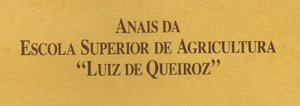Resumos
Plantas de arroz, variedades IAC-25 e IAC-47 foram cultivadas em solução nutritiva completa e com excesso de Al, Cl e Mn (25, 1750 e 25 ppm, respectivamente). As últimas não completaram o ciclo. Foram observados sintomas típicos de toxidez. A produção de matéria seca foi mais afetada pelos tratamentos na variedade IAC-47. Ambas as variedades mostraram-se mais sensíveis a toxidez de Mn que à de Al. Foram determinados os teores foliares de Al, Cl e Mn associados à toxidez correspondente.
Rice plants were grown either in full strength nº 2 solution of HOAGLAND & ARNON (1950) or in the same with high levels of Al, Cl and Mn (25, 1750 and 25 ppm, respectively). Plants with excess of each element did not complete the reproductive phase of development. Symptoms of toxicity appeared in response to the high levels supplied in the substrate. Dry matter production was relatively more affected in the case of the variety IAC-47. On the other hand, both varieties were more sensitive to Mn toxicity than to Al excess. The leaves had the following levels of the elements under the respective treatments, respectively for the variety IAC-25 and for the variety IAC-47; Al-107 and 221 ppm; Cl-87,500 and 17,500 (lower and upper leaves), 44,125 and 16,250 (lower and upper leaves); Mn - 1,670 and 1,769. The Al content of the roots was 5,639 and 5,872 ppm. Al toxicity decreased P content in all plant parts.
Estudos sobre a nutrição mineral do arroz. XIV. efeitos dos excessos de Al, Cl e Mn nas variedades IAC-25 e IAC-47* * Com ajuda do CNPq e da FAPESP.
Studies on the mineral nutrition of the rice plant. XIV. effects of excess of Al, Cl and Mn on the varieties IAC-25 and IAC-47
E. MalavoltaI; P.N.A. BertoII; P.S. KatayamaII; P.M. Santos
II; R.A. ArevaloII; R.L. RufinoII; R.V. NavesII; T.E. RodriguesII; J.S.T. LeiteII; S.R.C. StippII; C. DaghlianII; W. AmaralII; C.P. CabralII; L.H.S. PavanIV; L.A. DarioIV; F.C. AntoniolliIV
IDepartamento de Química, E.S.A. "Luiz de Queiroz", USP
IIEstudantes de pós-graduação
IIIAuxiliar de Laboratório, CENA-USP
IVTécnicos de Laboratório, Departamento de Química, E.S.A. "Luiz de Queiroz", USP
RESUMO
Plantas de arroz, variedades IAC-25 e IAC-47 foram cultivadas em solução nutritiva completa e com excesso de Al, Cl e Mn (25, 1750 e 25 ppm, respectivamente). As últimas não completaram o ciclo. Foram observados sintomas típicos de toxidez. A produção de matéria seca foi mais afetada pelos tratamentos na variedade IAC-47. Ambas as variedades mostraram-se mais sensíveis a toxidez de Mn que à de Al. Foram determinados os teores foliares de Al, Cl e Mn associados à toxidez correspondente.
SUMMARY
Rice plants were grown either in full strength nº 2 solution of HOAGLAND & ARNON (1950) or in the same with high levels of Al, Cl and Mn (25, 1750 and 25 ppm, respectively). Plants with excess of each element did not complete the reproductive phase of development. Symptoms of toxicity appeared in response to the high levels supplied in the substrate. Dry matter production was relatively more affected in the case of the variety IAC-47. On the other hand, both varieties were more sensitive to Mn toxicity than to Al excess. The leaves had the following levels of the elements under the respective treatments, respectively for the variety IAC-25 and for the variety IAC-47; Al-107 and 221 ppm; Cl-87,500 and 17,500 (lower and upper leaves), 44,125 and 16,250 (lower and upper leaves); Mn - 1,670 and 1,769. The Al content of the roots was 5,639 and 5,872 ppm. Al toxicity decreased P content in all plant parts.
Texto completo disponível apenas em PDF.
Full text available only in PDF format.
Co-autores
estudantes de pós-graduação A. Flórío, A.P. Orellana, A.P. Cruz, A.A. Frenhani, A.T. Silva, B.N. Rodrigues, C. Nóbrega, D.F. de Azeredo, E.M. Paulo, F.A. Oliveira, H.H.G. Pereira, L.A. Gomes, I.A. Guerrini, I.F. Carneiro, J.A. Mazza, J.C.A. Silva, J.C. Sabino, J.V. Ramos, J.C.D. Chaves. L.H.G. Chaves, L,A. Daniel, L.S. Corrêa, M.A. Schiavuzzo, M.P. Costa, N.A. Costa.
LITERATURA CITADA
Entregue para publicação em 23/12/81.
- HOAGLAND, D.R.; ARNON, D.I., 1950. The water culture method for growing plants without soil. Calif. Agr. Exp. Sta. Cir. 347.
- KAMPRATH, E.J.; FOY, CD., 1972. Lime-fertilizer-plant interactions in acid soil. Em: Fertilizer Technology and Use, Edit, por R.A. Olson et al., Madison.
- MALAVOLTA, E.; SARRUGE, J.R.; BITTENCOURT, V.C., 1976. Toxidez de alumínio e manganês. Em: IV Simpósio sobre o Cerrado, págs. 275-202, Coord, por M.G. Ferri, Livraria latiaria Editora Ltda e Editora da USP, S.Paulo.
- MALAVOLTA, E., 1981. Manual de Química Agrícola - Adubos e Adubação, 3a. ed., Editora Agronômica Ceres Ltda, São Paulo.
- TANAKA, A.; NAVASERO, S.A., 1966. Aluminum toxicity of the rice plant under water culture condition. Soil Sci. Plant Nutrition 12(2): 9-14.
- TANAKA, A.; YOSHIDA, S., 1970. Nutritional disorders of the rice plant in Asia, The IRRI, Los Baños.
- UEXKULL, H. VON, 1976. Response of H; y N rice to potassium. Results of long term fertilizer trials in the Philipines. Potash Rev. Subject 9 (11): 1-8.
Datas de Publicação
-
Publicação nesta coleção
12 Abr 2012 -
Data do Fascículo
1981
Histórico
-
Recebido
23 Dez 1981

